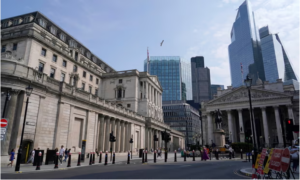Policymakers vote 8-1 against back-to-back cuts in borrowing costs after inflation stayed above Bank target

Threadneedle Street has cautioned against expectations for rapid reductions in borrowing costs, forecasting that inflation is on track to rise later this year. Photograph: Alberto Pezzali/AP
The Bank of England has kept interest rates unchanged at 5% as it put its efforts to ease the pressure on household budgets on hold.
The Bank’s monetary policy committee (MPC) voted by a majority of eight to one against launching a back-to-back reduction in borrowing costs amid concerns over lingering inflationary pressures.
The Bank last month cut interest rates for the first time since the Covid pandemic was declared four years ago, after a sharp fall in inflation from a peak of more than 11% in late 2022 – the highest level since the early 1980s.
Andrew Bailey, the Bank’s governor, said inflationary pressures had continued to ease, but cautioned against expectations for rapid interest rate cuts.
The annual rate of inflation remained unchanged at 2.2% in August, marginally above the Bank’s 2% inflation target.
The decision to keep rates on hold had been widely expected in the City. The pound jumped to its highest level against the dollar since March 2022 after the Bank’s decision, hitting $1.33.
“The economy has been evolving broadly as we expected. If that continues, we should be able to reduce rates gradually over time. But it’s vital that inflation stays low, so we need to be careful not to cut too fast or by too much,” Bailey said.
The development comes after the US Federal Reserve cut interest rates by half a percentage point on Wednesday, the first reduction in four years, as the world’s most powerful central bank stepped back from its aggressive bid to cool inflation in the American economy. The European Central Bank has also cut interest rates twice, by a quarter of a percentage point at non-consecutive policy meetings.
Most economists predict the Bank will resume cutting rates within months should inflationary pressures in the UK economy continue to fade, with financial markets pricing in the expectation of a further quarter-point reduction in borrowing costs to 4.75% at its next policy meeting in November.
Inflation in the UK has fallen back from a peak of more than 11% in the second half of 2022 after Russia’s invasion of Ukraine triggered a surge in energy prices, falling back earlier this year to more manageable levels close to the Bank’s 2% target.
Since cutting interest rates last month the MPC said inflationary pressures had continued to ease as expected. One member of the committee, the independent economist Swati Dhingra, voted for another immediate quarter-point cut in borrowing costs, going against most of the nine-strong panel.
However, the Bank warned headline inflation was on track to rise to about 2.5% before the end of this year – a marginally lower level than it anticipated in August – amid resilient price growth in the UK service sector and a tight jobs market.
In the minutes of its meeting, the MPC said: “Monetary policy would need to continue to remain restrictive for sufficiently long enough until the risks to inflation returning sustainably to the 2% target in the medium term had dissipated further.”
Highlighting concerns over inflation above the 2% target, the central bank said it would maintain a process of selling government bonds amassed on its balance sheet under its crisis-era quantitative easing programme.
Threadneedle Street said it would reduce the stock of UK government bonds by £100bn over the next year, aiming to reduce the total amount to £558bn. At its peak, the Bank held up to £895bn of bonds, in a policy designed to lower borrowing costs and keep markets functioning efficiently during the 2008 financial crisis and peak of the Covid pandemic.
The development is likely to be closely watched by the chancellor, Rachel Reeves, before next month’s budget, amid speculation she could change the government’s self-imposed fiscal rules to exclude the impact of the Bank’s quantitative easing programme.
Some economists have suggested such a change could open up additional headroom of about £20bn.


